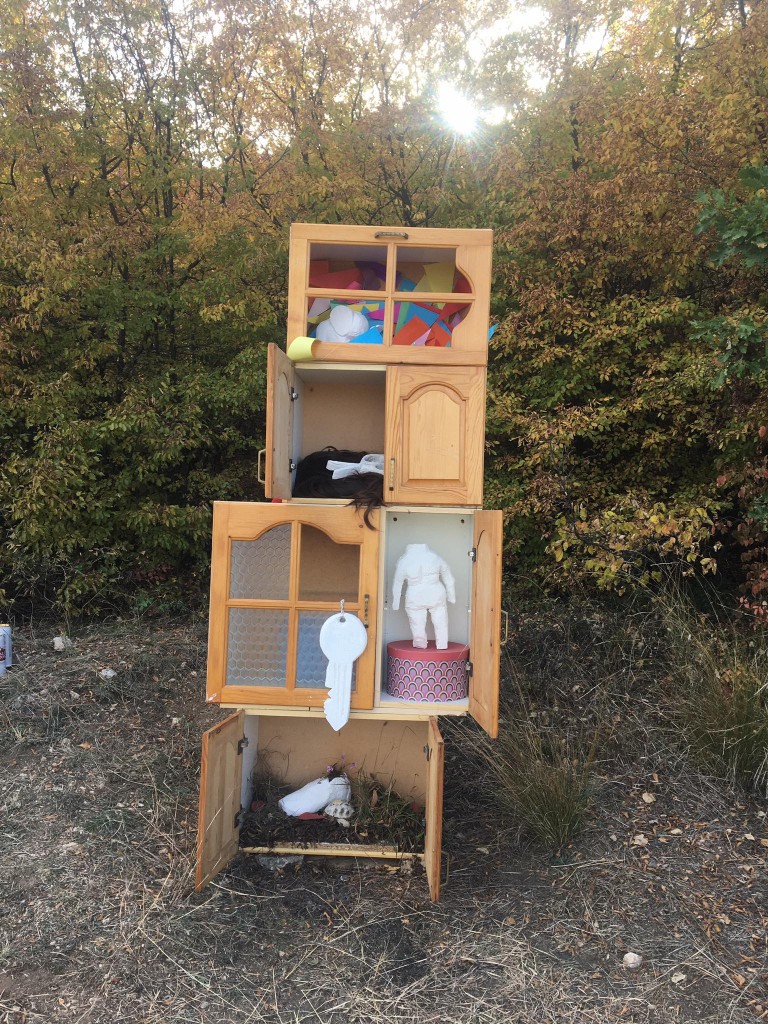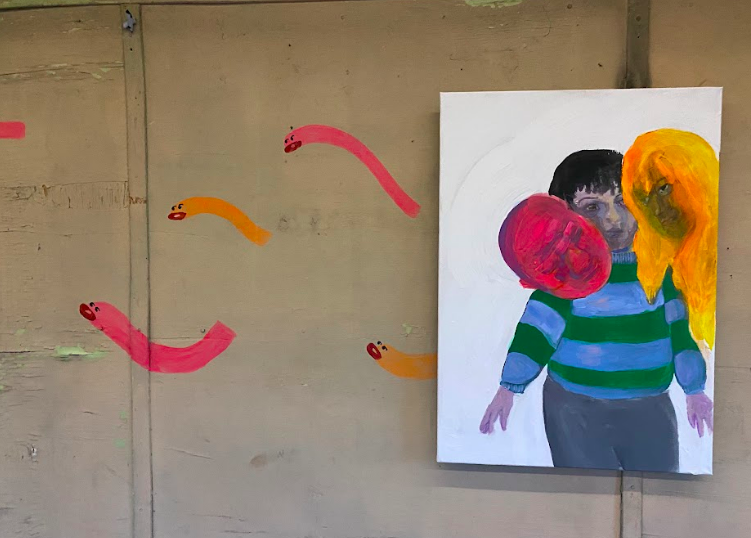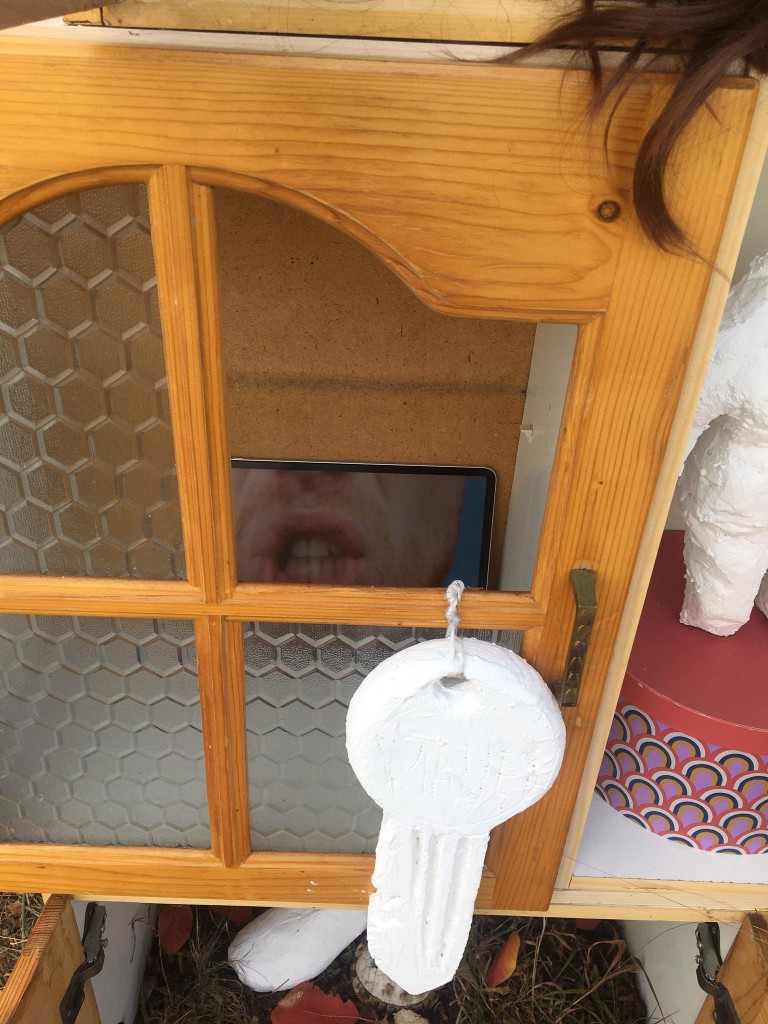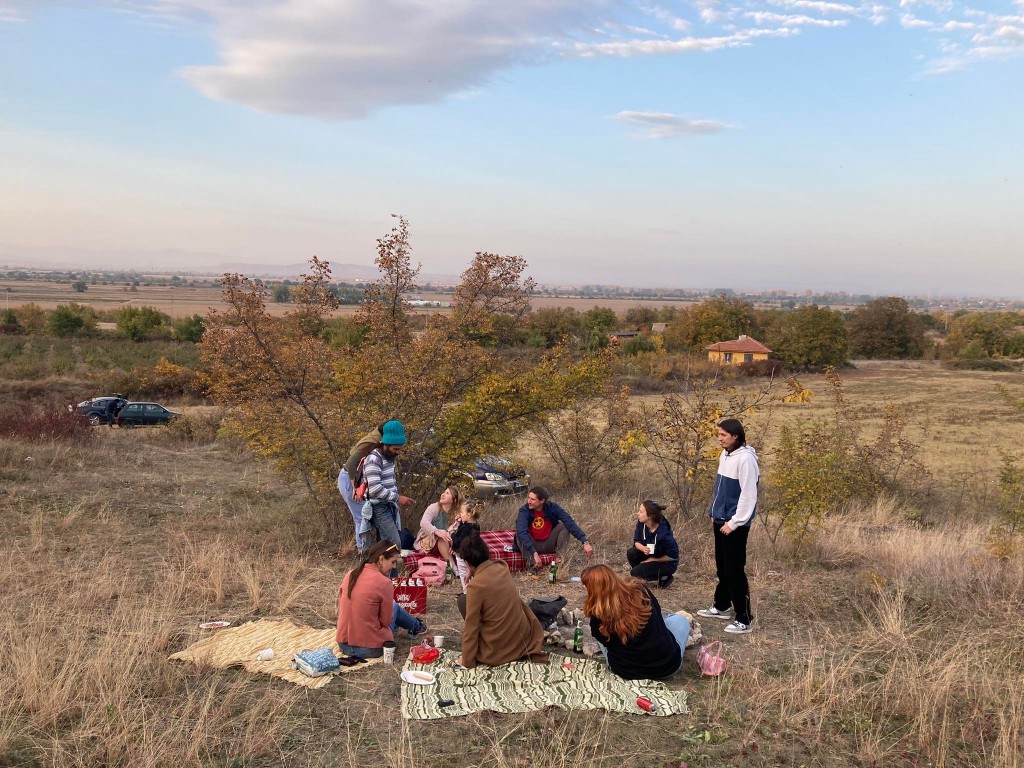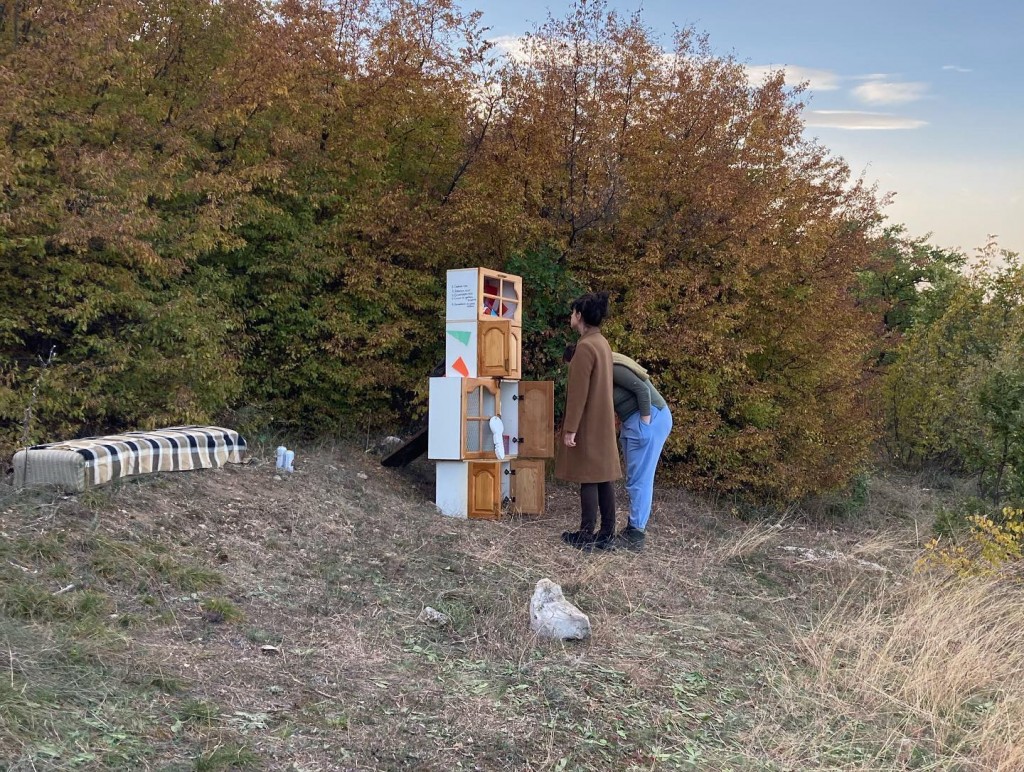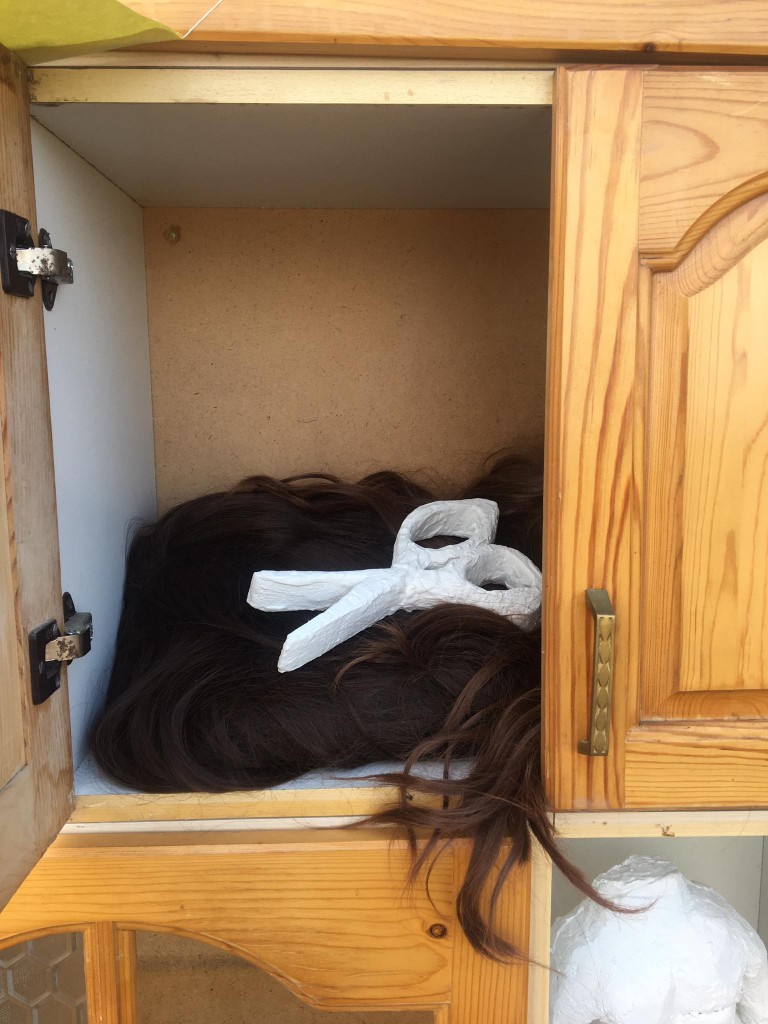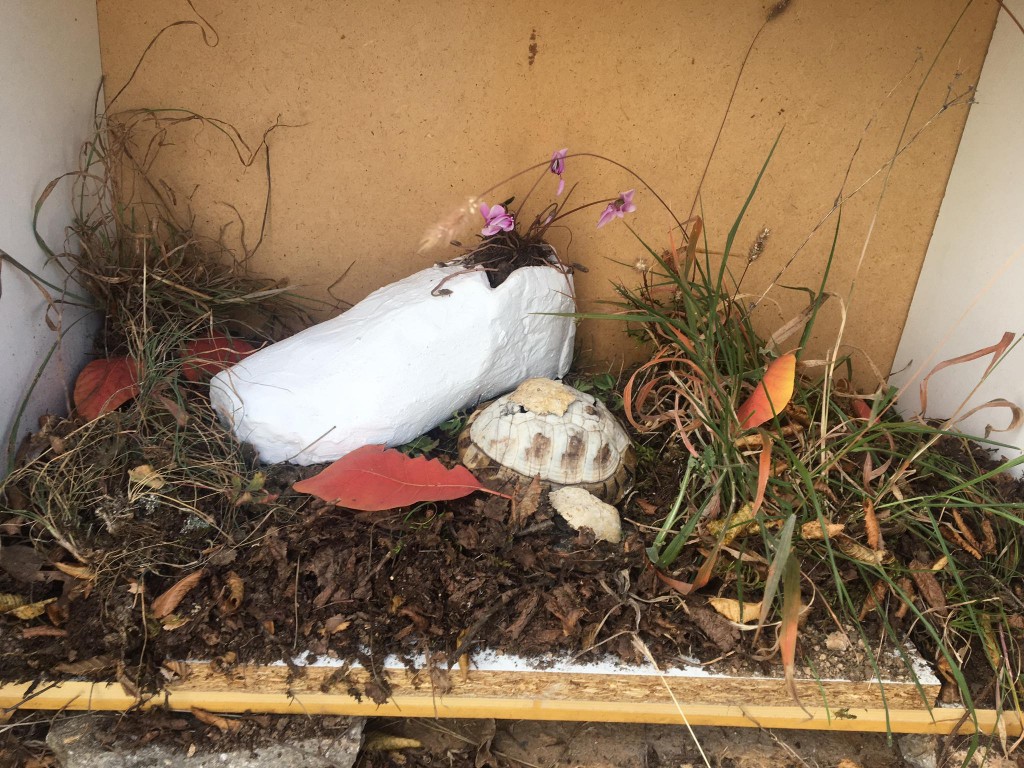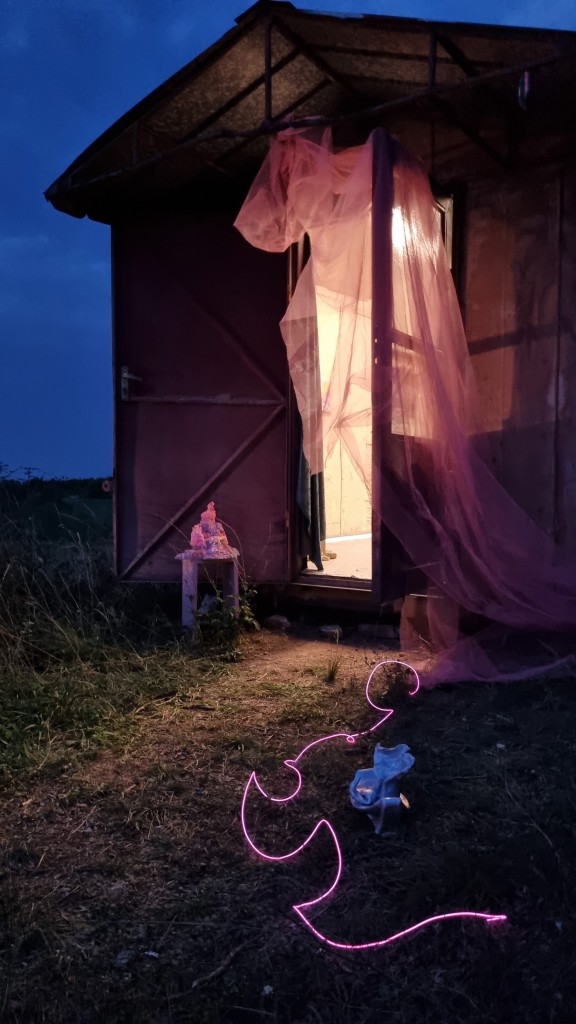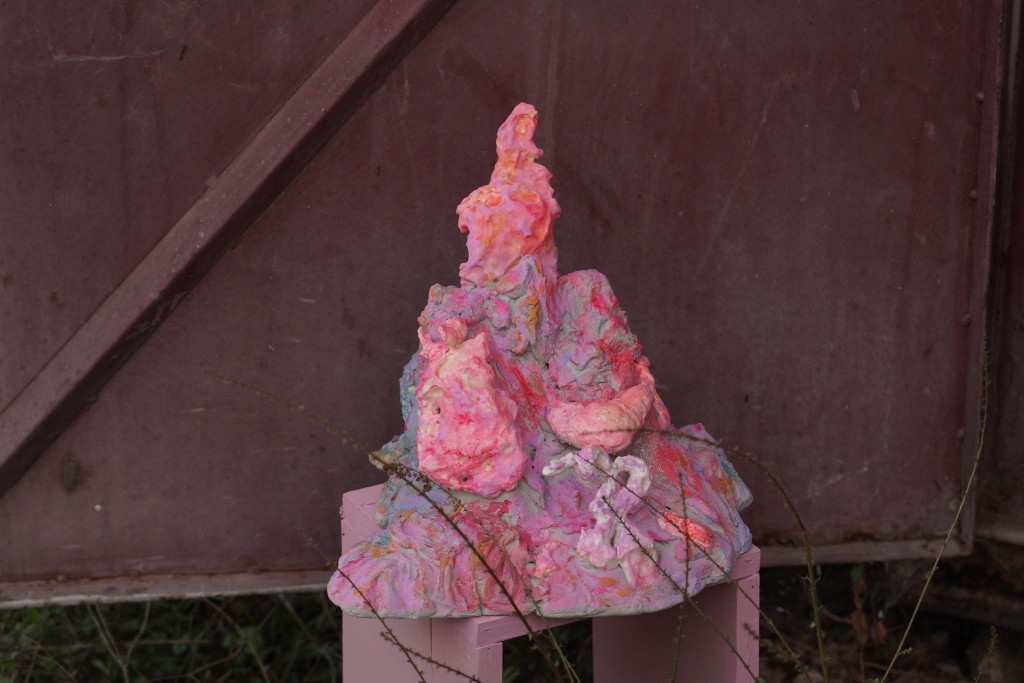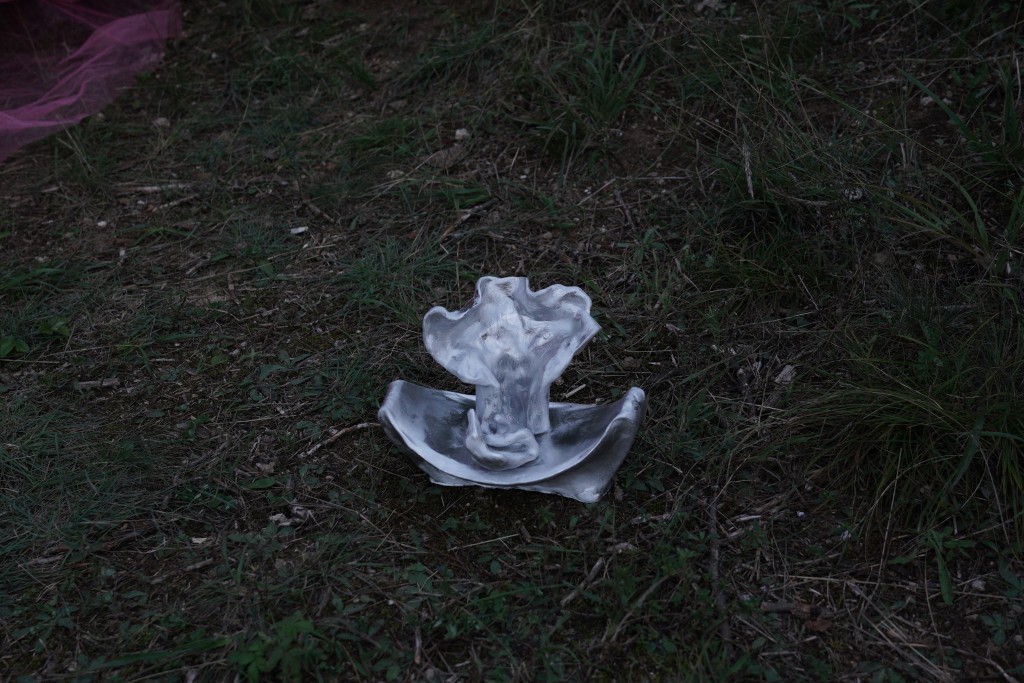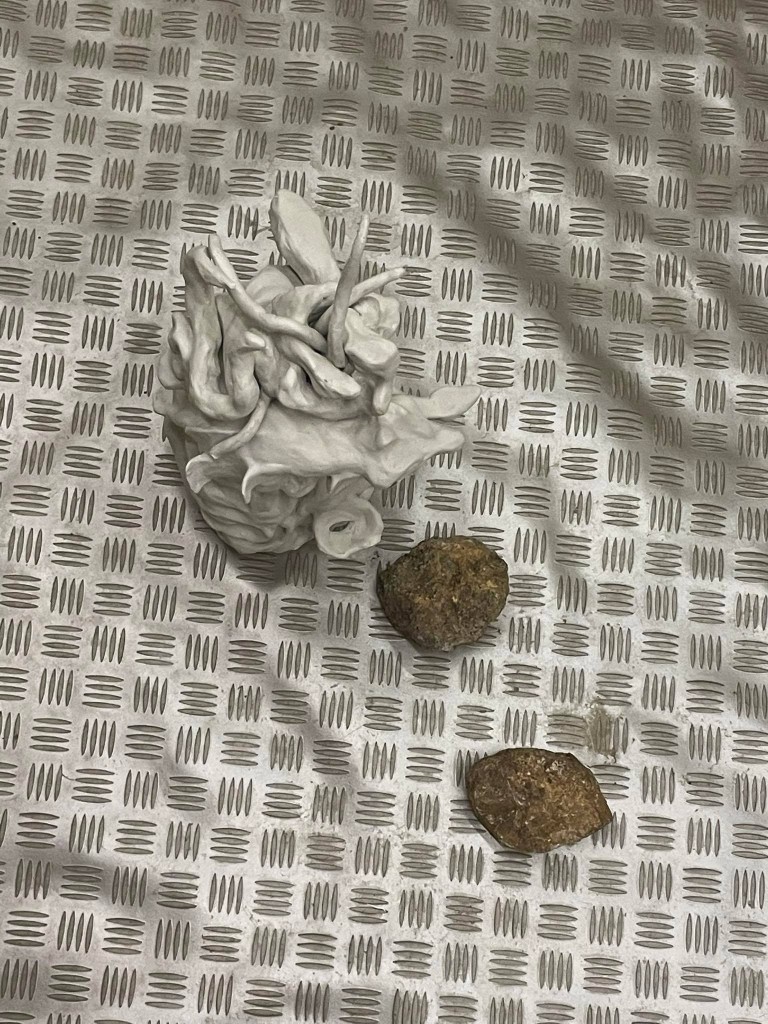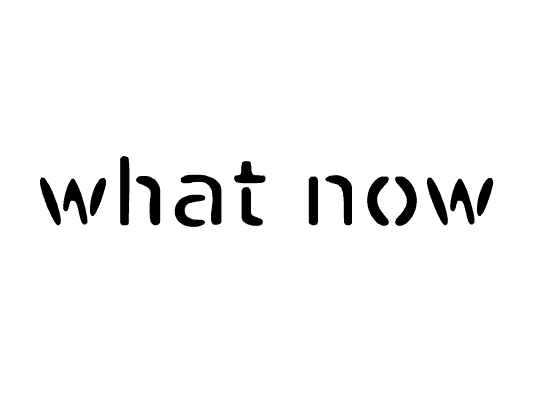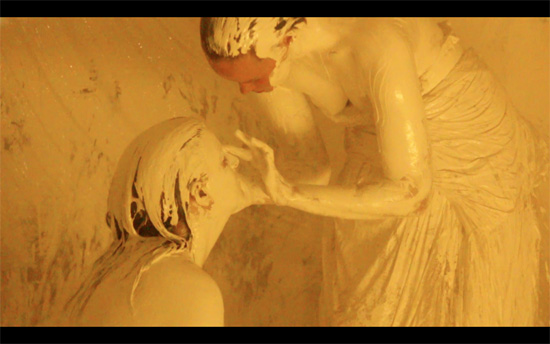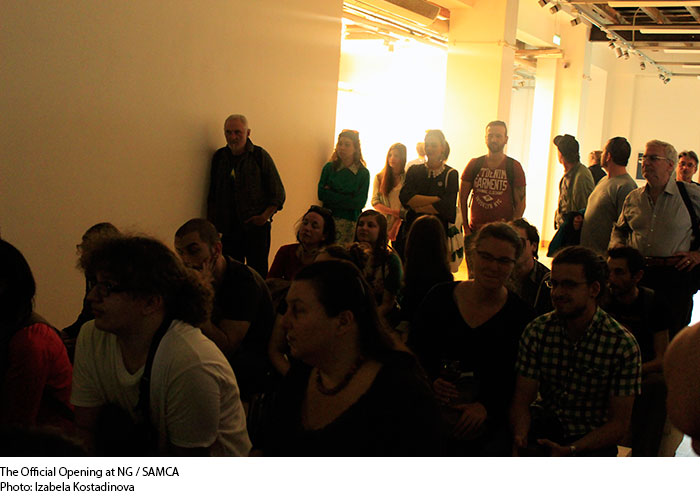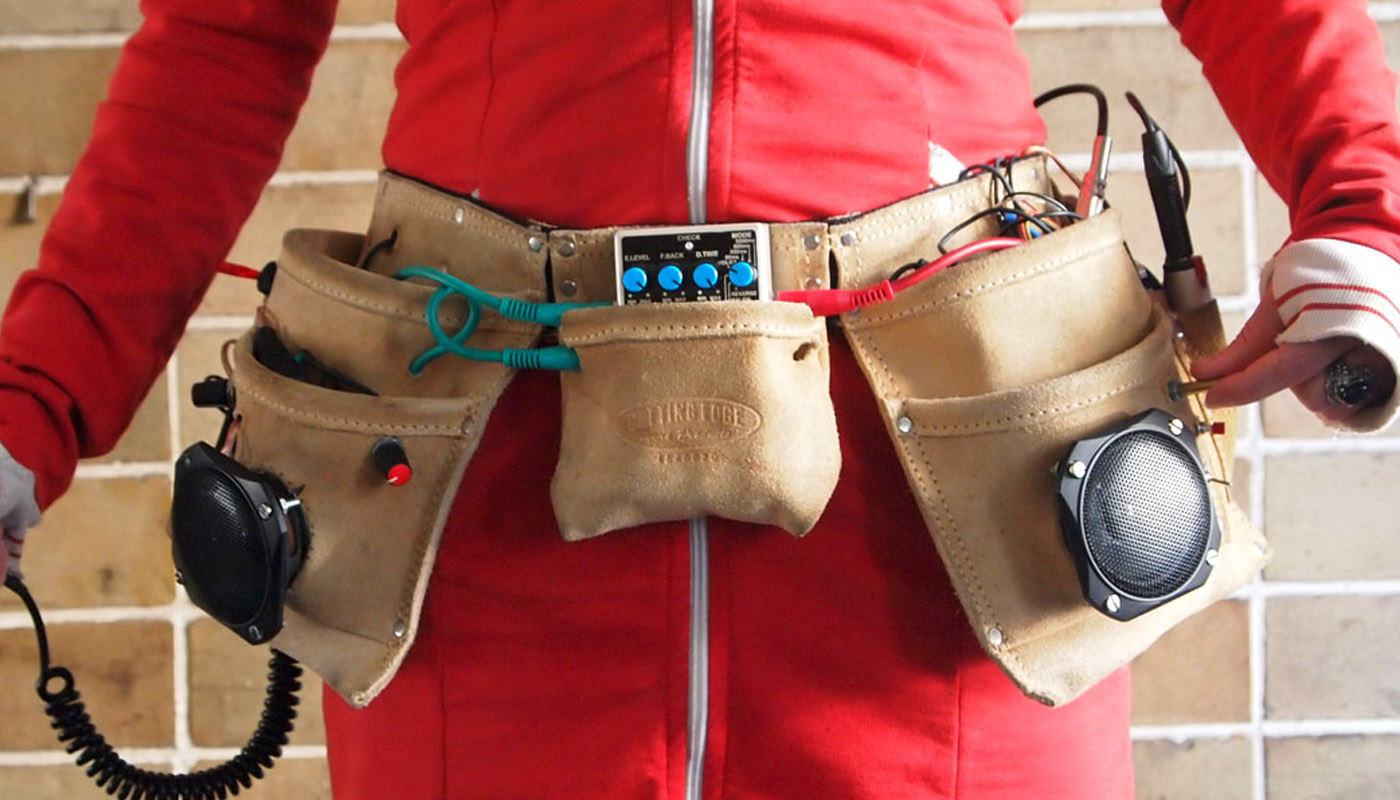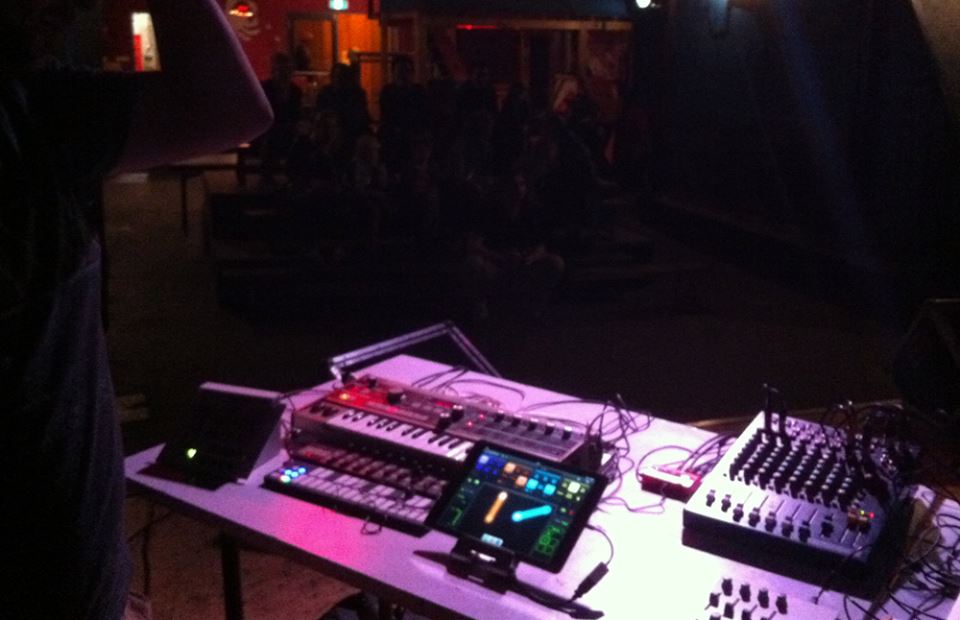lo3eto.brief.talks: ALEKSANDRA LASKOVA
Between October 22 and November 6, 2022, at lo3eto was presented Aleksandra Laskova’s solo show under the title WEIGHT SHIFT, curated by Vanya Grozdanova(c) Aleksandra Laskova, WEIGHT SHIFT (installation view outside)
|
lo3eto.brief.talks: MAGDALENA GINCHEVA
(c) Magdalena Gincheva, KIND OF PRETTY MUCH EXISTING AROUND THE GRAPE (detail)
|
lo3eto.brief.talks: VALKO CHOBANOV
|
|
Sofia Underground 2018 – Open Call for Participation
|
Sofia Underground is an independent participatory and inclusive community-oriented initiative dedicated to serve as a platform for flexible and experimental showcasing of performance art and other contemporary art forms. In 2017 Sofia Underground marked its 20th anniversary and closed a chapter in it’s history. Over 65 participants from more than 30 countries took part in the event, spread over 8 locations, and a week-long program – the longest and most intense edition of the oldest festival for contemporary and performance art in Bulgaria. It asked and answered a lot of questions related to time, space and durability. In 2018 Sofia Underground will present the traditional three modules – live art, talks and an exhibition, although it will return with another approach to the artists and the public, conceptualized as a reflection over the feedback of its experience so far. Physically participating artists will be personally invited to realize specially developed projects. It will also feature an exhibition with carefully selected via open call video documentation of performance art works. SOFIA UNDERGROUND 2018 WHAT NOW / NOW WHATTwo simple words questioning the present state of our mere existence as humans. What is now? What is contemporary in present-continuous tense? What is contemporary art and the role of the audience now and here? *As proposed by Bruce Sterling more than a decade ago in 2004 in his article Delete our cultural heritage? The open call for participation in the upcoming 2018 edition of Sofia Underground could be downloaded here. |
About Antibody-ness as a Form of Expression
|
Adam Rose and April Lynn are Chicago based artists involved with performance art who are also thrilled about presenting their work in various contexts around the world. In the middle of their world tour this summer they had a chat with Ivo Ivanov (Sofia Underground) about influences and what is it to be an antibody performance artist on the road.
Ivo Ivanov (II): So, I guess the first thing I should ask you is: what does performance art mean to you? Do you have your own definition for that? Can you say that what you do is performance art? Adam Rose (AR): For me performance art now means a space where new forms of expression can exist. Originally it comes from visual art, whereas dance comes from the traditional performing arts, but there are some forms of radicalized dance that cross into performance, or look like performance art. What we’re doing is more radicalization of traditional forms like music and dance.
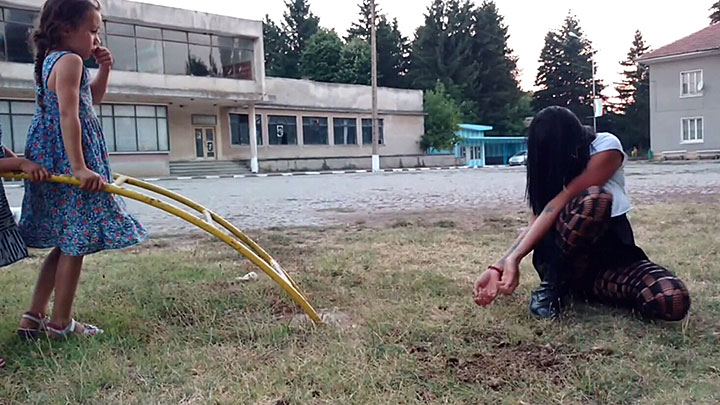 Palamartsa, Bulgaria, 2016 ©Ivo Ivanov
II: You’re a classically trained musician. How did you get involved in performance art and why? AR: I studied music at Ohio State University. My cello teacher told me I lacked body awareness and that my technique was suffering as a result. He had me take an Alexander technique course that focused on body awareness and posture. Soon after I began to improvise movement on my own and dropped out of college, because I had lost interest in classical music. I took two years off and got involved in activism. Then I went to Antioch College where I took a course that had a dance component and liked it a lot. We had this bio portrait project where I made a piece about Antonin Artaud that was a dance and got a good reaction. The dance professor Jill Becker encouraged me to continue and I ended up graduating with a Bachelors in Dance. That’s how it began. Afterwards I moved to Chicago and founded Antibody Corporation.
II: What is the concept behind Antibody Corporation? How does it relate to performance art? AR: The central concept of Antibody Corporation is the antibody itself. The word “antibody” implies a body against itself, or some form of “negative” body. With that we play with the idea of negation, negativity and conflict: conflict as a form of action, conflict as process — to set into motion the mind-body conflict. Or to turn the traditional mind-body hierarchy on its head. Body over mind. Prioritizing the body as the origin of culture.
II: So, the mind is not the origin? AR: This is a philosophical and scientific problem: the division between the mind and body. You can’t separate the mind from the body. Most of those wrong ideas come from religion, which claims spirit as the origin of everything. With antibody I take this apart and rearrange it to reintegrate mind and body. It’s an endless conflict that produces many new associations and combinations of ideas.
II: Last year you participated in the Sofia Underground festival doing three separate performances, which strongly involved the audience. How did that feel? What can you tell me about that experience? AR: Last year I was touring with Non Grata as part of their nomadic Diverse Universe festival. I joined the tour through six different countries – Estonia, Latvia, Lithuania, Bulgaria, Greece and Germany. I was really impressed with the organization of Sofia Underground and the spirit of the whole event. The industrial nature of the literally underground hall provided a good context for a dance that involved the audience. Also, as part of my practice I like to just take photos of buildings and empty spaces imagining the way an animal body might move through, or against them. It relates to Antibody’s aesthetic, the element of corporate mimicry, or critique of institutions. The first performance in Sofia was a dance with written choreography based on common words for the body’s parts i.e. hands, arms, feet, legs and head. I invited two audience members to join the performance by executing a simple routine of hops. I also composed the accompanying music. The second performance in Sofia was an improvised talk about E-Prime, a form of English that eliminates use of the verb “to be”. I framed it as an English teaching exercise and it was partly humorous, so the audience reacted with amusement.
I felt Sofia has similarities with my hometown of Chicago. Chicago is a working class city with a lot of empty and repurposed industrial spaces like factories and warehouses. My last performance for Sofia Underground in Plovdiv relied the most on audience interaction. I asked the audience members to sing parts of an old Motown song with me. Then I invited them to play inside a wooden structure in front of the Kosmos cinema, as if it were a forest. We moved around inside with our eyes closed to activate the tactile sense. People used their voices to help guide each other trough this kind of maze. Local artist Boyan Avramov played accompanying acoustic sound with a chain and a metal lid. I remember him saying that I “made a miracle” by getting the hesitant audience to participate in the performance.
II: Is that your usual approach? How important is interaction for you? AR: It’s not always necessary, but on that tour I was focused on involving the audience; asking them to translate bits of text into the local language. I used a text like: “Art is bullshit. Murder is wrong. The sky is blue.” – cliché statements that all use the verb “to be.” I‘d say that audience participation usually requires some use of language. And dance cannot easily communicate instructions or specific ideas to an audience. Dance lies mostly outside of translation. I try to reveal the gap between dance and language.
II: Now you’ve started to use your own invented language. Was it the next logical step to bridge the physical expression and the mindset programmed by language? AR: It was a natural progression to deepen our critique of the English language by developing our own as an alternative. It is called Lashtek. The name simply means “language”. Lashtek excludes the verb “to be” and uses a Verb-Object-Subject word order. Using this grammatical form prioritizes action and movement as central features of reality. It challenges the idea of fixed identity promoted by the use of English i.e. “I am male. I am American.” It aims to clarify an understanding of a world in motion, rather than a permanent, unchanging world. We live in a world full of transformation, movement and conflict. For me the logic of fixed identity leads to depressing emotional conclusions. To say “I am sad,” implies that I will always be sad, instead of accurately viewing my emotions as transient and always changing. Further, this relates to dance as an art form founded on the idea of movement, of a body in motion.
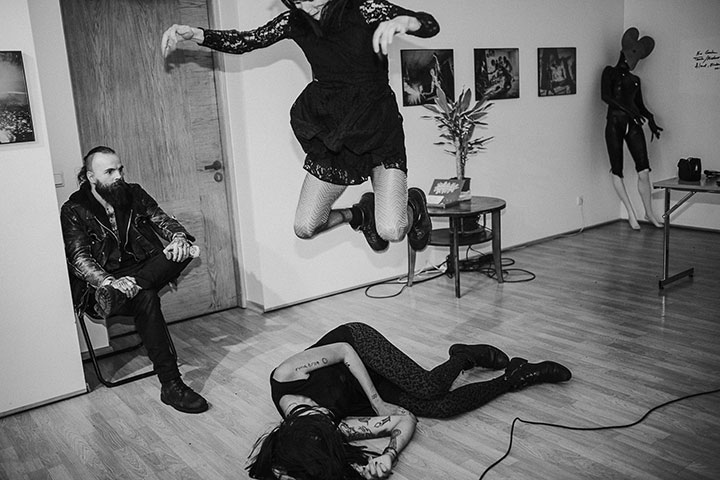 Pärnu, Estonia, 2016 ©Caroline Sada
II: You’re back in Bulgaria now with your partner April Lynn. How did you guys meet? April, why did you decide to join him for this tour? April Lynn (AL): We’ve known each other for many years. In 2011 we were part of a group show by our friend Glen Jennings. We have a lot a mutual creative interests. I don’t have a degree in dancing, but in visual arts, but I love to dance and perform and I’ve been doing this my whole life. And last fall he invited me to perform with him and everything happened kind of naturally. I’ve realized I’ve been antibody my whole life.
II: What does that mean? AL: Growing up as a tall biracial girl in Northern Minnesota wasn’t easy. So, I’ve always felt a disconnect within myself and interactions with other people socially. I was marked as different because of my height and skin tone. I always stood out, never being able to blend in. I was aware of this disconnection and was trying to find a way to fit into the society around me and to fit into my own body.
II: Was performance the way to express this discomfort? Does it help? AL: I’m 31, so at this point I know my own body very well. I’ve been performing forever quite unintentionally. Recently I feel like I’m performing with a clear intention, an idea of what we want to evoke, though my movements are quite improvised in the moment directed by the space and the people around.
II: Is your work site-specific then? How important is the local context to what you do? AL: We try to incorporate the audience with our own language, wherever we perform, responding to the space we’re in. Utilizing the differences in each structure we perform in, taking advantage of all aspects of the space, good or bad, is a practice that is common for many artists.
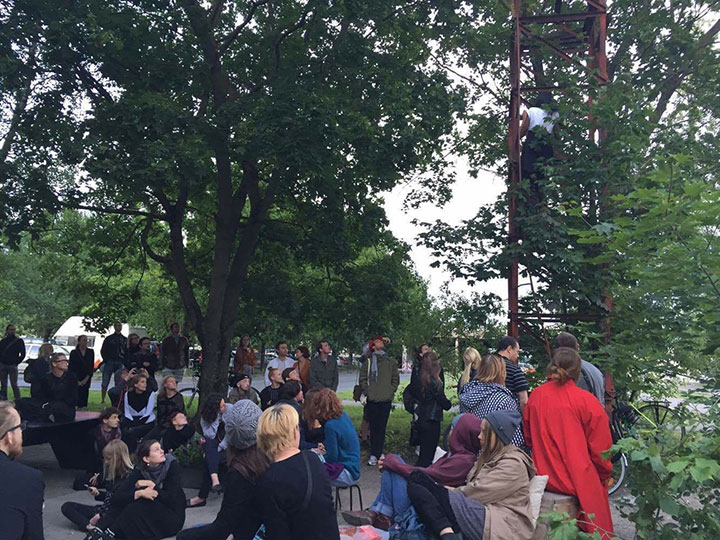 EKKM Estonia ©Pille Laiakask
II: You’re near the end of your European tour. What are the highlights so far? Where was the most interesting location or audience? AR: We made six different performances in Romania, Bulgaria, and Estonia. Each place we performed in had something interesting about it. Our first performance at REACTOR in Cluj, Romania, had a really engaged audience. They asked us a lot of questions afterwards. AL: Someone gave me a handcrafted necklace as a gift after the show. I feel like I have friends in Cluj now. AR: In Bucharest, Romania we performed at Green Hours jazz-café, an underground club which has been in existence since 1994. Through talking with its owner, Voicu Radescu, we got to learn some of its history as one of the oldest alternative spaces in Bucharest. EKKMi Kohvik hosted the performance we did in Tallinn, Estonia. Seeing the Contemporary Art Museum of Estonia (EKKM) and performing there was interesting for me, because I work as a security guard at the Museum of Contemporary Art in Chicago. The EKKM did not have security guards. The building it was housed in began as a squat that later became official and legalized. Because of this, it seems they can take more risks than larger institutions and show work that is new and exciting. AL: We performed in an outdoor space in front of the Museum. We both scraped our knees and shed a little blood on the gravel area. There was an old metal tower-like structure there that we climbed up as part of the end of our performance. We had a great time! AR: In Pärnu, Estonia, we performed at the Kunstnike Maja, as part of a group exhibition organized by Non Grata and others. In this way, the tour came full circle from last year, performing as part of Diverse Universe hosted by Non Grata again. This was the last time we performed Antiworlds in Europe, and for that reason it felt the most intense and complete in some way. AL: I agree, performing in Pärnu was a perfect end to the European leg of the tour. A few hours later we found ourselves swimming in the Baltic Sea at night. The water was cold, but it was so beautiful I didn’t want to leave. I almost got hypothermia. I had a great time!
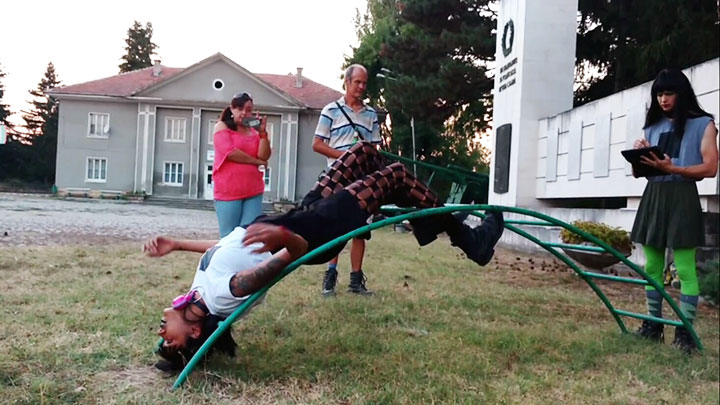 Palamartsa, Bulgaria, 2016 ©Ivo Ivanov
II: You just did a performance in the central square of Palamartsa village. Nothing like that has ever happened there. People didn’t know what to expect — the surprise element was on your side. What are your impressions? Did it feel very different from a show in an institutionalized space with a more educated crowd? AL: Yes, of course it felt different. The number of British ex-pats living in the village was surprising, and many of them came to see us perform. At the beginning of the performance, I read a text in Lashtek, then walked around, asking audience members to read parts of it out loud as well. One woman refused at first, wanting to know if the words we were asking her to read had any meaning. So many different personalities were present. A group of people had just come from the nearby pub. Afterwards a young girl and her father talked with us. She said she liked our movement, and wanted a photo with us. She became maybe Antibody’s youngest fan. If children see our performances, they’re usually scared by it. So this was noteworthy. AR: In Palamartsa’s main square, we began our performance in front of a monument dedicated to fallen soldiers. This was important for me, because I like monuments and that sense of history. Now, some decades later some weird artists from the US are performing in front of it with an android tablet and bluetooth speaker, dancing around. I’m not sure if something like we did has never happened in Palamartsa before. I feel like events always repeat themselves. Maybe many years ago a group of performers created something strangely similar there and everyone has forgotten. Before and after the performance, we handed out fliers with info about the performance, and our Lashtek alphabet printed on the back. We had never shared our alphabet before. It felt correct and meaningful to share it for the first time in Bulgaria, as this is the place where the Cyrillic alphabet originated. A couple who own a house in Palamartsa, and also live in Morocco, afterwards wanted to know how to say and spell “magical love” in our language. I wrote it out for them in the alphabet: “MAATEKYSH XXAALAA.” They liked it, and said they would name their house in Palamartsa this.
II: How should Antibody Corporation change in order to stay current within the contemporary art scene? Antibody Corporation changes naturally on its own, just as everything else does. We don’t try to stay relevant, but instead approach current events and trends from a certain oblique angle. We have arrived now in Shiryaevo, Russia, where we will present as part of the Shiryaevo Biennale of contemporary art. The Biennale began in 1999, and this is its ninth iteration, yet we are the first US citizens to participate in it, which is an honor. The subject of this year’s Biennale is CASH, and we are approaching this by thinking about physical currency in relation to the materiality of the body, and dance as a medium of exchange between bodies. From what we hear, it seems there is not a big scene or market for contemporary art in Russia. But this makes it a more interesting context to make performance in. Once again, we are staying in a rural village like Palamartsa, and preparing a performance to present at the dock by the Volga River. After this, we will land in New York city, the home of the US’ art market and financial markets.
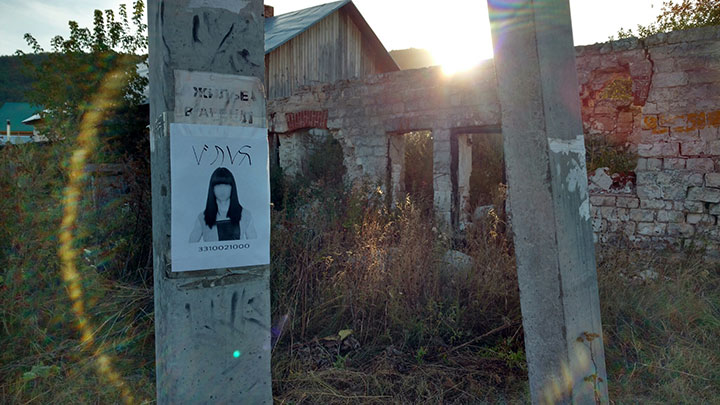 Shiryaevo, Russia, 2016 ©Antibody Corporation
Further Antibody related view you are to enjoy following these links: http://www.antibodycorp.org/events.html https://antibodycorporation.bandcamp.com/
|
Sofia Underground as a Form of Protest
|
This interview was first published online in Bulgarian in the portal Culture.bg on the 3rd of Mai 2016.
Sofia Underground was held for the twelfth time from the 19th until the 24th of April 2016. Its main stage for a second year in a row was the electro-control room of the National Palace of Culture.
|
Sofia Underground 2016 – Inner Conflicts
|
Sofia Underground ’16 – a festival for performance and border art forms – has just finished its 12th edition, built over the concept Inner Conflicts and realized between 19 and 24 April in a few various locations in the city of Sofia, Bulgaria. The program of the event presented over 60 artists, coming from 13 different countries. It was created through the selection of this year’s festival curator – Ivaylo Ivanov, who has chosen the participants stepping on an open call for artist acts based on the announced concept. The main program of the festival, the so called Underground, happened in two following days in the weekend, taking place in the industrial underground space of the Electro-control hall of the National Palace of Culture (near its building Lumiere Cinema), which for a second subsequent year the organizers of the event manage to integrate due to the needs of the independent contemporary cultural practices. The intensive and rich program presented various performance acts – diverse in character and expressiveness, while enduring from 7 p. m. on Friday and 5 p. m. on Saturday till 3 a. m. during the night, slowing transforming in a culminating way to content of audio-visual performances in the field of electronic music and media arts. As in previous years, this time again, in addition to the program of performances to the attention of the public, were presented a screening program of video art works and a few art installations.
Following its already somehow established status of a platform, which is presenting and connecting independent artists in the field of contemporary art practices, in ’16 Sofia Underground again managed to set a program, balanced between Bulgarian and foreign participants, as well as between established and emerging artists, thus encouraging their interaction and sharing of experience, while supporting the development of the local art scene. The involvement of the audience, which is another important focus in the programming of the event, in this edition of the festival was provoked by the interactive performances as well as through the special supporting program of the festival.
The warming up part of the program, named Higher ground, gave the audience the opportunity to attend some introductory for the discourse of the event lectures and artist talks by local and guest artists. They were held at the places of the NG / Sofia Arsenal Museum for Contemporary Art (in which collection actually, is included the documentation of the first editions of Sofia Underground), also, the “Man and Earth” National Museum and the “Red House” Centre for Culture and Debate. Sofia Underground 2016 ended with a post-program, named Overground, within which metaphorically, as a representation of a kind of a sociocultural “inner conflict”, in the festival was integrated one, locally active during the past years, public debate and the protest related to it.
The artists, presented at Sofia Underground 2016 – Inner Conflicts: The festival Sofia Underground 2016 is realized by Studio DAUHAUS and eXAF.org, in cooperation with the Congress Center of the National Palace of Culture, and with the support of the Polish Cultural Institute in Sofia and Gaudenz B. Ruf Award for Contemporary Bulgarian Art. Additional support for the event was received by the European Cultural Foundation, Goethe-Institut Berlin, Goethe-Institut Munich, State Institute for Culture to the Minister of the Foreign Affairs of Bulgaria, OCB and V/HOD – platform for documentary arts. * * * The organizers are grateful to all the large number of volunteers, which actively supported the preparation and the realization of the event, as well as specially thank to TimeHeroes.org for their support in our work with the volunteers. We also thank to all artists, who participated in Sofia Underground 2016, being open and supportive and who helped us conduct a content of quality, no matter the lack of financial and institutional support, which were the conditions of the 2016 edition of the festival. Our team is expressing gratitude to the team of DNA – space for contemporary dance and performance, which helped us in the realization of the dance performance in our program. We are thankful to all those of you who decided to stand behind us, while doing Sofia Underground 2016. And, last but not least, we greet our special audience! Get ready for the upcoming next explicit edition – Sofia Underground 2017 – when the festival is having its 20th anniversary! SU’16 team
|
DARK LIGHTS: félin amour @ Night ’15, Plovdiv
|
Visual identity: So Many Stories To Tell |
Steffi Weismann @ Sofia Underground 2015
|
Just before the opening of Sofia Underground 2015, I had the pleasure of meeting one of our international artists- Steffi Weismann. We talked about her long-term relationship with machines and the performance she has prepared for us tomorrow. Make sure you don’t miss it.
About Steffi Weismann
Machines
About coming to Bulgaria
Check our program here and be on time for the opening tomorrow! |
Backpullver @Sofia Underground 2015
|
On 25th of April at The Energy Source Center of the National Palace of Culture (under Lumiere Cinema) starting at 23:30, as a part of Sofia Underground 2015 – Machines, the sound will be held by Backpullver. Engineer Tzvetomir Krumov and Emil Hristov (together a.k.a. ZDimension until 2003) are Backpullver. During the years they had some rare and memorable festival appearances – Ambient Fest, Underground:United, Djebel Basma Service, Орг.Орг fest and a few small concerts at the Art Hostel, Sfumato Theatre, The Red House. Latest show in Bulgaria was at Krasno Selo cultural institute, which got fully recorded: In 2010 the duo was joined by German Germanov (aka The Saint Inspector, Oppidian) who brought new horizons and verticals in the x and y axis. They play with home made machines and controllers. Just for fun, without being pretentious, no posing and no remorse. They leave the seriousness to the specialists, because they are none. Their last gig was in 2014 in OCCI, Amsterdam: fB: http://www.facebook.com/thebackpullver Soundcloud: https://soundcloud.com/backpullver-1
|
about this blog
|
Here we publish interviews and interesting facts. You can find the events we’re organizing here: https://www.facebook.com/exaf.org/events and here: http://exaf.org/en/upcoming
|
 English
English  Bulgarian
Bulgarian 